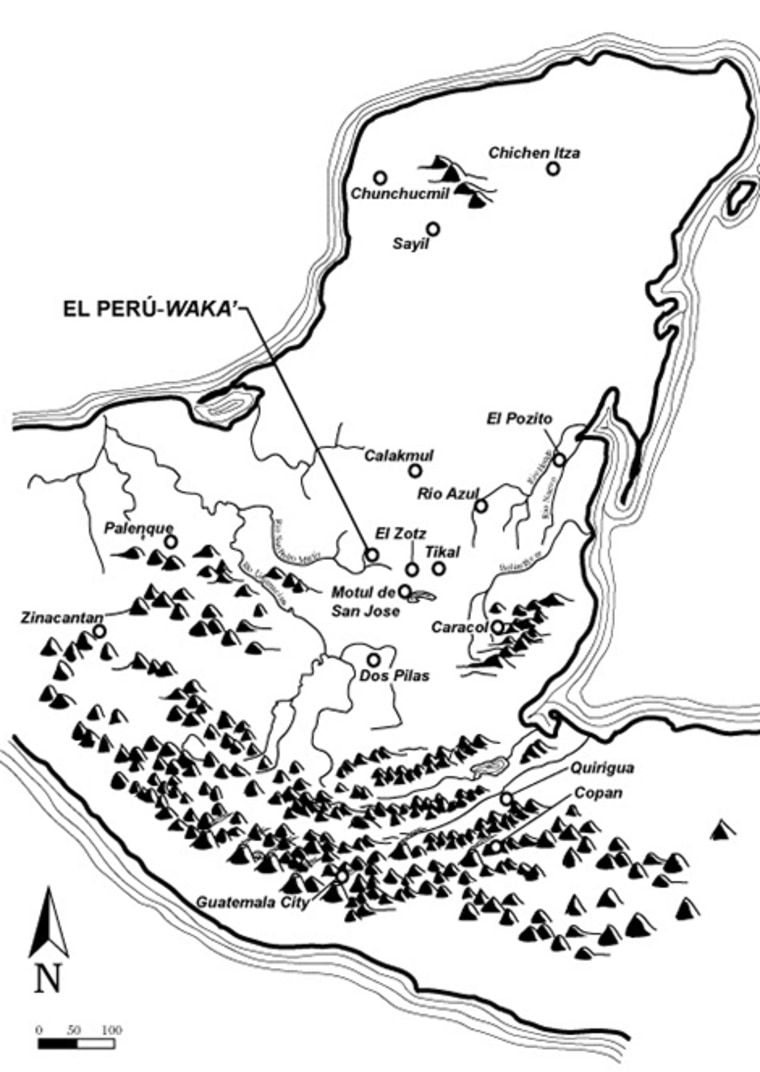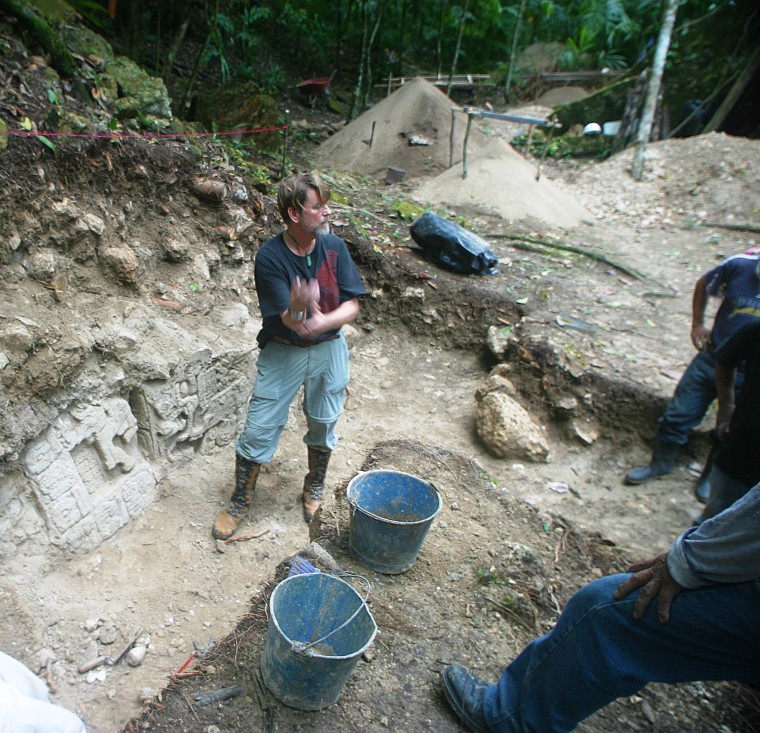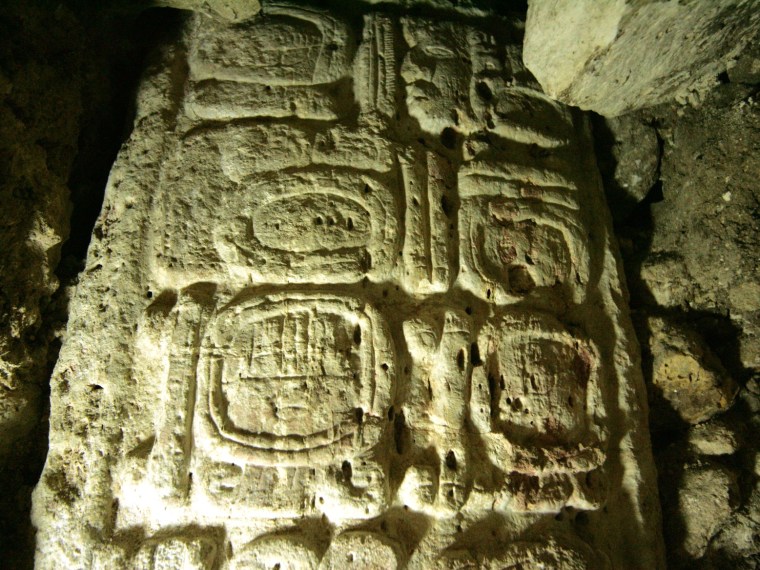Archaeologists say a 1,450-year-old stone monument discovered beneath a Maya temple in Guatemala bears hieroglyphs that hint at a multigenerational tale of power reminiscent of "A Game of Thrones."
"'Game of Thrones' ... George Lucas ... Steven Spielberg ... Nobody could write this story the way the Maya actually lived it," David Freidel, an anthropologist at Washington University in St. Louis, told NBC News.
Freidel is part of the international research team that unearthed the monument in March at the El Peru-Waka archaeological site in northern Guatemala. El Peru-Waka served as one of the power centers for the Maya civilization more than a millennium ago.
The monument, known as Stela 44, was dedicated in the year 564, the researchers reported. The glyphs suggest it was commissioned by a king named Wa'oom Uch'ab Tzi'kin to honor his father, King Chak Took Ich'aak (Red Spark Claw), who died about eight years earlier. The monument also mentions a queen, Lady Ikoom, who was apparently Red Spark Claw's wife.
Freidel said the inscriptions on Stela 44 suggest that Lady Ikoom used the monument to solidify her family's hold on power in El Peru-Waka — and deliver a dig at her former overlords.
""There's something very delicious, about vengeance being a dish that's best served cold," he said.
Factions fit for the 'Game of Thrones'
This is where the "Game of Thrones" connection kicks in: At the time, El Peru-Waka was a kingdom caught between the era's two Maya superpowers: the dynastic kingdom of Tikal, and the dominion of the Snake Lords. For fans of the George R.R. Martin books or the HBO television series, think Lannisters vs. Targaryens.

Based on the references on the monument, plus other references from Maya lore, Red Spark Claw was a vassal of Tikal — while Lady Ikoom apparently traced her lineage to the Snake Lords. Those affiliations, added to the timing of the monument's dedication, evoke a tale of political intrigue.
Between 556 and 564, the Maya political landscape underwent a huge turnabout, with the Snakes on the rise and Tikal in decline. Freidel surmises that Red Spark Claw might have been killed by Tikal's ruler in 556 — and that the resulting scandal could have contributed to the Tikal king's downfall. That king, named Wak Chan K'awiil, was sacrificed by the Snake king in 562.
In Freidel's view, Lady Ikoom was sending a message in the monument that was dedicated two years after the Tikal king's execution: The inscription emphasized her son's claim to power in Waka through his father's Tikal connections, but also pointed to her own Snake connections. The hieroglyphs even note that her son was put into power by Wak Chan K'awiil. Freidel reads that as a tweak to the Tikal king who killed Red Spark Claw, only to lose his own life to the Snake Lords.
It's as if the dragon queen from "Game of Thrones," Daenerys Targaryen, had a son by Ned Stark — and then erected a monument to lord it over the Lannisters, who were once allied with the Starks but became their foes.
Reversals of fortune
Stela 44 is badly worn in places, and Freidel said the wear pattern suggests that the monument was removed from its original position and discarded for a time. That could have happened in the 7th century, when a different king of Tikal took control of the region including Waka. "He's not happy about that stela, because Lady Ikoom would have been a great enemy of his family," Freidel said.
The tide turned yet again later in that century, with the Snake Lords' allies retaking Waka. One of the principal figures of that era was Lady K'abel, who held the title of "Supreme Warlord" in Waka. Last year, Freidel and his colleagues unveiled evidence suggesting that K'abel was as powerful in her day as Cleopatra was in ancient Egypt — or as Queen Daenarys is in the fictional "Game of Thrones."
The way Freidel tells it, the monument was rescued and buried as an offering in Waka's newly constructed temple around the year 700, probably as part of the funeral rituals for Lady K'abel. Stela 44 thus might have served as a tribute not only to Lady K'abel — but also to Lady Ikoom, her powerful predecessor in the Snake Lords' lineage,
Freidel said it's "exhilarating" to see how newly found artifacts like Stela 44 can flesh out the tale of Maya political intrigue. But for now, the evidence is so fragmentary that he's had to speculate about what happened during the gaps in the archaeological record. Freidel acknowledged that not everyone agrees with his interpretation. More study will be required before this "Game of Thrones" story gains full acceptance as historical fact.
"The 'Game of Thrones' works among modern-day archaeologists, and not just among the ancient Maya," Freidel joked.

More about the Maya:
- Tiny jar identifies mighty Maya queen
- Archaeologists dig into tangled Maya roots
- NBC News archive on Maya civilization
For more about Stela 44 and its meaning, check out the news release from Washington University in St. Louis, as well as this technical summary of the project (downloadable Word document), The discovery was announced by the Guatemala Ministry of Culture and Sports on Tuesday.
Freidel has directed research at the El Peru-Waka site in collaboration with Guatemalan and foreign archaeologists since 2003. Juan Carlos Pérez Calderon is co-director of the project, and Olivia Navarro Farr, an assistant professor at the College of Wooster in Ohio, is co-principal investigator and long-term supervisor of work at the temple, known as Structure M13-1. Guatemalan archaeologist Griselda Perez discovered Stela 44 in this temple.The project carries out research under the auspices of the Ministry of Culture and Sports of Guatemala and its Directorate for Cultural and Natural Patrimony, the Council for Protected Areas. Research is sponsored by the Foundation for the Cultural and Natural Patrimony and the U.S. Department of the Interior.
Alan Boyle is NBCNews.com's science editor. Connect with the Cosmic Log community by "liking" the NBC News Science Facebook page, following @b0yle on Twitter and adding +Alan Boyle to your Google+ circles. To keep up with NBCNews.com's stories about science and space, sign up for the Tech & Science newsletter, delivered to your email in-box every weekday. You can also check out "The Case for Pluto," my book about the controversial dwarf planet and the search for new worlds.
